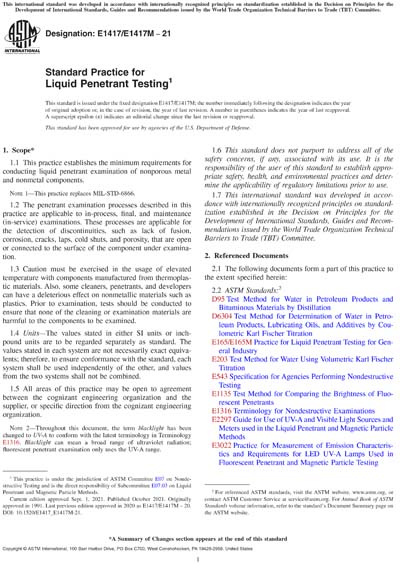Historical
ASTM E1417/E1417M-21
Standard Practice for Liquid Penetrant Testing
1.1This practice establishes the minimum requirements for conducting liquid penetrant examination of nonporous metal and nonmetal components.
Note 1:This practice replaces MIL-STD-6866.
1.2The penetrant examination processes described in this practice are applicable to in-process, final, and maintenance (in-service) examinations. These processes are applicable for the detection of discontinuities, such as lack of fusion, corrosion, cracks, laps, cold shuts, and porosity, that are open or connected to the surface of the component under examination.
1.3Caution must be exercised in the usage of elevated temperature with components manufactured from thermoplastic materials. Also, some cleaners, penetrants, and developers can have a deleterious effect on nonmetallic materials such as plastics. Prior to examination, tests should be conducted to ensure that none of the cleaning or examination materials are harmful to the components to be examined.
1.4Units - The values stated in either SI units or inch-pound units are to be regarded separately as standard. The values stated in each system are not necessarily exact equivalents; therefore, to ensure conformance with the standard, each system shall be used independently of the other, and values from the two systems shall not be combined.
1.5All areas of this practice may be open to agreement between the cognizant engineering organization and the supplier, or specific direction from the cognizant engineering organization.
Note 2:Throughout this document, the term blacklight has been changed to UV-A to conform with the latest terminology in Terminology E1316. Blacklight can mean a broad range of ultraviolet radiation; fluorescent penetrant examination only uses the UV-A range.
1.6This standard does not purport to address all of the safety concerns, if any, associated with its use. It is the responsibility of the user of this standard to establish appropriate safety, health, and environmental practices and determine the applicability of regulatory limitations prior to use.
1.7This international standard was developed in accordance with internationally recognized principles on standardization established in the Decision on Principles for the Development of International Standards, Guides and Recommendations issued by the World Trade Organization Technical Barriers to Trade (TBT) Committee.
Content Provider
ASTM International [astm]






